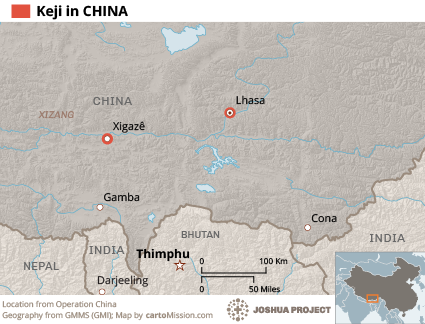There are two groups of Muslims in Tibet. The larger group are the Hui: Chinese-speaking Muslims who are descended from Arab and Persian traders. The Hui are believed to have migrated into Tibet some time before 1766. The second group are the Keji. "The Kejis have their ancestral roots in Kashmir, India, from which their ancestors migrated in the 1600s. They came to Tibet as traders and still earn a comfortable living that way." The Keji in Lhasa were noticed by the 5th Dalai Lama (1617-1682). "The Dalai Lama spotted a [Keji] man at prayer every day ... worshiping according to the precepts of his religion ... on the hill because no mosque existed in the area. Impressed with his faith, the Dalai Lama sent a bowman to a site near the hill and had him shoot arrows in each of the four cardinal directions. A house was built at the place from which the arrows were shot, and the land around it, extending as far in each direction as the arrows had flown, was deeded to the Muslim community. The place came to be called The House of Far-Reaching Arrows and became the site of Lhasa's first mosque and cemetery."
The Keji have been included in the Hui nationality in China simply because they are Muslims. The proud Keji, however, speak Tibetan and are ethnically distinct. Few people are aware of the existence of the Keji in Tibet. One writer notes, "Even the Chinese Encyclopedia on Nationalities makes no mention of their existence."
The Keji have their own Islamic restaurants, tea shops, and mosque in Lhasa. Keji women in some locations wear a distinctive blue dress.
All Keji are Sunni Muslims. Islam in Tibet dates back to when the ruler of Kabul, a vassal of the Tibetan king, converted from Buddhism to Islam between AD 812 and 814. "As a token of his sincerity, he presented ... a gold statue of the Buddha, which was melted down to make coins."
There has never been a known Christian among the Keji in Tibet. Because all missionaries who go to Tibet focus on the needs of the Tibetans, the Keji have yet to hear the gospel for the first time in their long history there.
Pray that the sheer wonder of knowing Jesus and the impact he has on their lives and the joy he brings spur believers to share Christ with the Keji people.
Pray the hearts of the Keji people would be stirred by a sovereign work of the Holy Spirit readying them for the time when they hear the gospel message being shared with them.
Pray they will experience dreams and visions of Jesus leading them into a saving relationship with him.
Pray for an unstoppable movement to Jesus Christ among the Keji people.
Scripture Prayers for the Keji in China.
Operation China, Asia Harvest, Copyrighted © Used with permission.
| Profile Source: Joshua Project |











